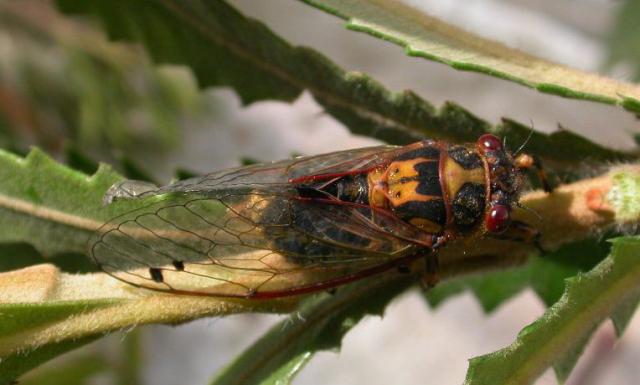The many colors of the Cyclochila australasiae
I asked Dr. David Emery to explain the different colors of the Cyclochila australasiae, a.k.a. the Green Grocer, Yellow Monday, Blue Moon, Masked Devil, etc. David has allowed me to use his explanation on the site, and here it is:
Most “green” cicadas like our GG (Green grocer – Cyclochila australasiae) are coloured from the mixture of yellow and blue pigments. It is quite common for the blue to be missing to various degrees in GGs, and they exhibit shades of lighter green to yellow (even close to orange) and are then called “Yellow Mondays!”. It is also common for the blue pigment to fade in collections and so many “green” species turn a dull beige or brown. This can be fixed with a 24h soaking in 2.5-10% neutral-buffered formalin immediately after killing (or inject formalin after they die). MUCH more rarely, the yellow pigment can be missing and then we get the “Blue Moon”- love those purple eyes! In fact, having collected or spotted more than 10,000 GGs in my time, I have not caught a Blue Moon. My daughter Samantha, found the one in the photo when she was 4 years old, and another when she was 7!!
The orange-black, “masked devil” morph of the GG seems associated with altitude and these progressively appear with increasing frequency amongst GG populations above 500m in the mountains west of Sydney. For example, at Glenbrook, (elevation 150m) they are <5% of the population whereas at Hazelbrook and Blackheath (670m and 1200m, respectively), they increase to around 95% of the population. It was thought that cold underground temperatures during larval and nymphal development might also contribute, but the huge numbers of green GGs west of our ranges argue against a direct effect of temperature alone. Here the winter temps are very cold too, just as cold as the mountains. So just how these “melanisation” effects are mediated remain unresolved- one of life’s tantalizing mysteries!
Here are photos of cicadas by David Emery. Take a look.
Australian Cicada Websites
- The Chambers Wildlife Rainforest Lodges has a page of cicada facts and photos of Northern Greengrocers and a Green Baron from Tropical North Queensland.
- The AusEmade: Cicada page features cicada facts, as well as a very nice matrix of Common cicada names, their Scientific names and where they can be found. The site was just updated with Orange Drummer photos.
- The Brisbane Insects site has a selection of pages devoted to cicadas found in the Brisbane area. There are information and photos of Double Drummers, Clangers, White Drummers, Brown Bunyips, Razor Grinders, Bladder Cicadas, Floury Bakers, Thin-striped Wattles, Small Bottle, Either Bark Squeakers, and Small Bark Squeakers.
- The CSIRO site has a great list of cicadas by Scientific name; there are photos for each species, general information including where they are found.
- The Summer of Singing Cicadas page on the Scribbly Gum site is filled with excellent information including cicada names, keeping cicadas as pets, their sound, their life cycle, The Black Prince, cicada myths and where they can be found.







